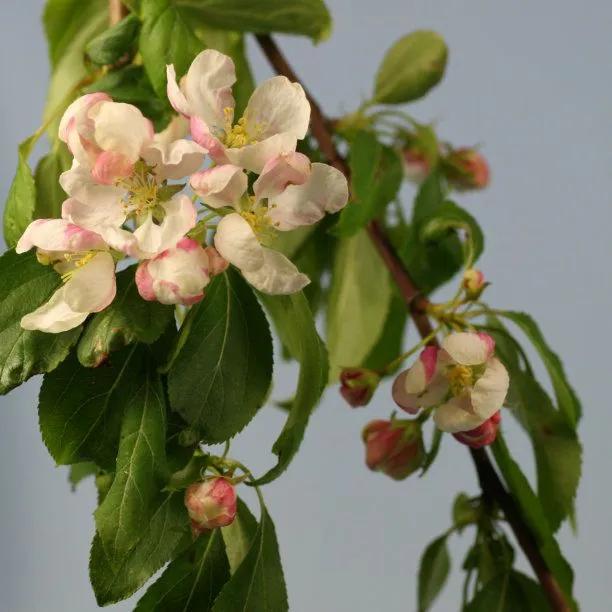Red Jade Crab Apple, Large Trees

The details
- Pink buds, pure white flowers.
- Little red fruits hang on branches into winter.
- Weeping habit
- Max. Height: 4m
- Bareroot Delivery: Oct-Apr.
Recommended extras
Description
Malus Red Jade: Bareroot Red Jade Weeping Crab Apple Trees in Standard Sizes
Malus scheideckeri Red Jade is a superb little weeping crab apple tree with pink buds that open into mostly white blossom and mature into little red fruit. The flowers are extremely profuse; some are creamy white and some retain some of the bud's pink pigment. A thriving tree in bloom will be swallowed up in flowers that nearly reach down to the ground. Once the tree is mature, it provides you with a yearly opportunity to lie down and relax directly under a thick canopy of flowers.
Red Jade's other great feature is the small, cherry-like red fruit, which are as plentiful as the flowers and hang onto the branches, giving you something nice to look at well into winter. If your tree is in a sheltered spot, there may still be one or two left hanging on when the tree starts to wake up in spring. The autumn colour is a mellow yellow.
Suitable for any garden, it will reach a height of between 3-4 metres.
Browse our variety of crab apple trees or our full range of ornamental garden trees.
Delivery season: Crab apple trees are delivered bareroot during late autumn and winter, approximately November-March inclusive.
Choosing a size: Small trees are cheaper, easier to handle and more forgiving of less than ideal aftercare, so they are best for a big planting project. If instant impact is your priority, or if you are only buying a few plants for use in a place where it is convenient to water them well in their first year, then you may as well use bigger ones. All our bareroot trees are measured by their height in centimetres above the ground (the roots aren't measured).
Features:
- Height: 3-4m (exceptionally 5m). Weeping habit
- Soil: Any fertile and well drained
- Use: Specimen, small garden, large container
- Colour: Mostly white flowers, touched with pink, in late April-May
- Bareroot delivery only: November-March
Growing Red Jade Crab Apples
Any well drained, fertile soil. Not recommended for poor, dry soil. Suitable for large containers designed for trees. Full sun or partial shade. Tolerant of pollution.
It is susceptible to scab, which is mostly a problem in the warmer, more humid parts of the South and West.
Planting Instructions
Notes on planting Malus Red Jade:
Crabapples are tough plants that thrive in any moderately fertile soil. They tolerate shade well, although we recommend planting them in full sun to get the best display of flowers and fruit. Although a moist, well drained site is ideal, crabapples like heavy clay and don't mind a bit of waterlogging in winter.
They won't grow in deep shade and may struggle in very poor dry soil.
Prepare your site before planting:
It is good to dig over the site where you plant a tree several months in advance. Kill the weeds first: for tough weeds like nettles, brambles and ground elder, you will usually need a weed-killer to get rid of them. When you dig the soil over, remove stones and other rubbish and mix in well rotted compost or manure down to the depth of about 2 spades.
Watch our video on how to plant a tree for full instructions.
Remember to water establishing trees during dry weather for at least a year after planting.
Tree Planting accessories:
Prepare your site for planting by killing the weeds and grass.
You can buy a tree planting pack with a wooden stake & rubber tie to support the tree and a mulch mat with pegs to protect the soil around the base of your tree from weeds and drying out.
We suggest that you use mycorrhizal "friendly fungi" on the roots of all newly planted large trees: if your soil quality is poor, we strongly recommend it.
You can also improve your soil with bonemeal organic fertiliser.
Did You Know?
This tree's parent is probably Malus Exzellenz Thiel, and it was selected from open pollinated seedlings by George M. Reed at the Brooklyn Botanic Gardens in the 1930's. It has been in widespread cultivation since 1953.
Standard trees are measured by their girth in centimetres 1 metre above ground level: their trunk's waist measurement. Unlike sapling trees and hedge plants, standards aren't measured by their height, which will vary quite a bit both between and within species.
So, a 6/8cm standard tree has a trunk with a circumference of 6-8cm and an 8/10 standard has a trunk 8-10cm around. This measurement makes no difference to the tree's final height.
On average, standard trees are 2-3.5 metres tall when they arrive, but we cannot tell you precisely how tall your trees will be before we deliver them.


